IQGAP1 links PDGF receptor-β signal to focal adhesions involved in vascular smooth muscle cell migration: role in neointimal formation after vascular injury
- PMID: 23657573
- PMCID: PMC3761176
- DOI: 10.1152/ajpcell.00011.2013
IQGAP1 links PDGF receptor-β signal to focal adhesions involved in vascular smooth muscle cell migration: role in neointimal formation after vascular injury
Abstract
Platelet-derived growth factor (PDGF) stimulates vascular smooth muscle cell (VSMC) migration and neointimal formation in response to injury. We previously identified IQ-domain GTPase-activating protein 1 (IQGAP1) as a novel VEGF receptor 2 binding scaffold protein involved in endothelial migration. However, its role in VSMC migration and neointimal formation in vivo is unknown. Here we show that PDGF stimulation rapidly promotes IQGAP1 association with PDGF receptor-β (PDGFR) as well as IQGAP1 tyrosine phosphorylation in cultured VSMC. Overexpression or knockdown of IQGAP1 enhances or inhibits PDGFR autophosphorylation (p-PDGFR), respectively. Immunofluorescence and cell fractionation analysis reveals that PDGF-induced p-PDGFR localized in focal adhesions (FAs), but not caveolae/lipid rafts, is inhibited by IQGAP1 knockdown with siRNA. PDGF stimulation promotes IQGAP1 association with PDGFR/FA signaling protein complex. Functionally, IQGAP1 siRNA inhibits PDGF-induced FA formation as well as VSMC migration induced by PDGF. In vivo, IQGAP1 expression is markedly increased at neointimal VSMC in wire-injured femoral arteries. Mice lacking IQGAP1 exhibit impaired neointimal formation in response to vascular injury. In summary, IQGAP1, through interaction with PDGFR and FA signaling proteins, promotes activation of PDGFR in FAs as well as FA formation, which may contribute to VSMC migration and neointimal formation after injury. Our findings provide insight into IQGAP1 as a potential therapeutic target for vascular migration-related diseases.
Keywords: IQGAP1; migration; platelet-derived growth factor; vascular injury; vascular smooth muscle cell.
Figures
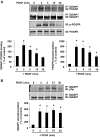
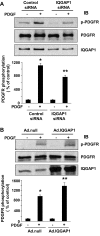
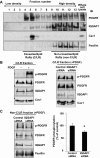
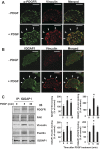

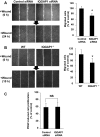

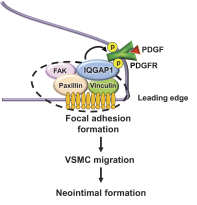
Similar articles
-
Increasing our IQ of vascular smooth muscle cell migration with IQGAP1. Focus on "IQGAP1 links PDGF receptor-β signal to focal adhesions involved in vascular smooth muscle cell migration: role in neointimal formation after vascular injury".Am J Physiol Cell Physiol. 2013 Sep 15;305(6):C579-80. doi: 10.1152/ajpcell.00125.2013. Epub 2013 May 8. Am J Physiol Cell Physiol. 2013. PMID: 23657571 Free PMC article. No abstract available.
-
Copper transporter ATP7A interacts with IQGAP1, a Rac1 binding scaffolding protein: role in PDGF-induced VSMC migration and vascular remodeling.Am J Physiol Cell Physiol. 2018 Dec 1;315(6):C850-C862. doi: 10.1152/ajpcell.00230.2018. Epub 2018 Sep 26. Am J Physiol Cell Physiol. 2018. PMID: 30257103 Free PMC article.
-
Novel role of copper transport protein antioxidant-1 in neointimal formation after vascular injury.Arterioscler Thromb Vasc Biol. 2013 Apr;33(4):805-13. doi: 10.1161/ATVBAHA.112.300862. Epub 2013 Jan 24. Arterioscler Thromb Vasc Biol. 2013. PMID: 23349186 Free PMC article.
-
Redox control of vascular smooth muscle migration.Antioxid Redox Signal. 2010 Mar 1;12(5):625-40. doi: 10.1089/ars.2009.2852. Antioxid Redox Signal. 2010. PMID: 19737088 Free PMC article. Review.
-
The role of extracellular vesicles in neointima formation post vascular injury.Cell Signal. 2020 Dec;76:109783. doi: 10.1016/j.cellsig.2020.109783. Epub 2020 Sep 18. Cell Signal. 2020. PMID: 32956789 Review.
Cited by
-
Simvastatin preparations promote PDGF-BB secretion to repair LPS-induced endothelial injury through the PDGFRβ/PI3K/Akt/IQGAP1 signalling pathway.J Cell Mol Med. 2019 Dec;23(12):8314-8327. doi: 10.1111/jcmm.14709. Epub 2019 Oct 1. J Cell Mol Med. 2019. PMID: 31576676 Free PMC article.
-
Silencing IQGAP1 alleviates hepatic fibrogenesis via blocking bone marrow mesenchymal stromal cell recruitment to fibrotic liver.Mol Ther Nucleic Acids. 2021 Dec 17;27:471-483. doi: 10.1016/j.omtn.2021.12.020. eCollection 2022 Mar 8. Mol Ther Nucleic Acids. 2021. PMID: 35036058 Free PMC article.
-
Increasing our IQ of vascular smooth muscle cell migration with IQGAP1. Focus on "IQGAP1 links PDGF receptor-β signal to focal adhesions involved in vascular smooth muscle cell migration: role in neointimal formation after vascular injury".Am J Physiol Cell Physiol. 2013 Sep 15;305(6):C579-80. doi: 10.1152/ajpcell.00125.2013. Epub 2013 May 8. Am J Physiol Cell Physiol. 2013. PMID: 23657571 Free PMC article. No abstract available.
-
IQGAP1 Is a Phosphotyrosine-Regulated Scaffold for SH2-Containing Proteins.Cells. 2023 Feb 2;12(3):483. doi: 10.3390/cells12030483. Cells. 2023. PMID: 36766826 Free PMC article.
-
A novel role for IQGAP1 protein in cell motility through cell retraction.Biochem Biophys Res Commun. 2014 May 23;448(1):39-44. doi: 10.1016/j.bbrc.2014.04.038. Epub 2014 Apr 18. Biochem Biophys Res Commun. 2014. PMID: 24747073 Free PMC article.
References
-
- Autieri MV. Increasing our IQ of vascular smooth muscle cell migration with IQGAP1. Focus on “IQGAP1 links PDGF receptor-β signal to focal adhesions involved in vascular smooth muscle cell migration: role in neointimal formation after vascular injury.” Am J Physiol Cell Physiol (May 8, 2013).10.1152/ajpcell.00125.2013 - DOI - PMC - PubMed
-
- Bensenor LB, Kan HM, Wang N, Wallrabe H, Davidson LA, Cai Y, Schafer DA, Bloom GS. IQGAP1 regulates cell motility by linking growth factor signaling to actin assembly. J Cell Sci 120: 658–669, 2007 - PubMed
-
- Brown MD, Sacks DB. IQGAP1 in cellular signaling: bridging the GAP. Trends Cell Biol 16: 242–249, 2006 - PubMed
Publication types
MeSH terms
Substances
Grants and funding
LinkOut - more resources
Full Text Sources
Other Literature Sources
Molecular Biology Databases
Research Materials
Miscellaneous

